If you want to travel to Ireland on your own motorbike and need a new set of tyres before your trip, the following article will be of interest to you.
Page Contents (click line to jump the text)
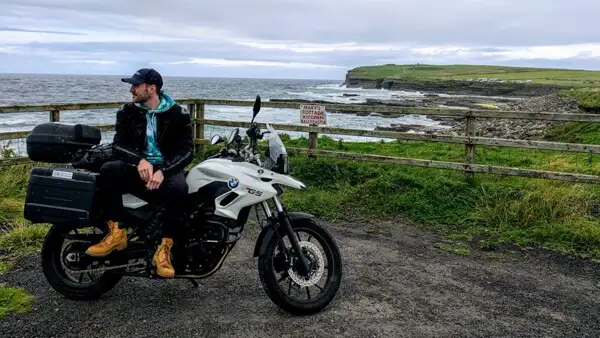
Intro
Through our (former) motorbike rental company in Ireland, we always have many different tyres on many different motorbikes, which I test extensively. I have been riding a wide variety of motorbikes myself for many years and many thousands of kilometres and also have some off-road experience.
I also personally know several professional motorbike tour guides with on- and off-road training, whose experiences I also include in this article. So these are long-term practical experiences that I share with you.
Summary for quick readers
In Ireland, especially the smaller country roads are often more polluted than in Germany. Rolling gravel from road construction, dirt from farming, as well as gravelled car parks and shoulder roads mean that motorbike travellers experience more loose and slippery surfaces than in Germany. Therefore, motorbike tyres with a slightly coarser tread of the categories (80/20) or even (70*30) are recommended for touring enduros in Ireland, even if no off-road use is planned.
Road conditions in Ireland
If you are coming from Germany, Austria or Switzerland, you will have to think a little differently in Ireland. Most country roads are extremely narrow and bends are usually confusing. Often it happens right in the bend: rolled gravel lies in the middle of the road or the farmer has his field access in the bend and has spread half the field on the tarmac. The only thing that helps is to drive slowly and, above all, to always drive in the left-hand lane, even in left-hand or right-hand bends.
Tarmac is a very common road surface in Ireland. It is closely related to asphalt, but it is much coarser and tends to break out as rolling gravel in potholes and cracks.
In road construction, fresh Tarmac is often covered with a closed layer of rolled chippings of varying thickness. This is no problem for off-road drivers, but for pure road drivers it is advisable to avoid this fresh road for safety’s sake and to look for a diversion.
In most cases, the rolling chippings are no longer swept away, but gradually move through the traffic. It accumulates for a while in the middle of the carriageway and on both sides of the road.

By the way, verges and car parks, even at places of interest, are often only gravelled. The gravel is usually not too deep and can (carefully) also be driven over by motorbikes of all kinds. Be careful with newly constructed parking bays, these can also have loose gravel.
Overall, however, even the pure road rider in Ireland gets loose or dirty ground under his wheels again and again – and that is what we are talking about here.
At first, this sounds more dramatic than it is: driving carefully and with foresight in the left lane usually solves the problem. And it’s not like there’s rolling gravel everywhere. Among other things, I rode about 25,000 km through Ireland on a Harley Fat Boy and that went without a hitch – with careful driving.
If you ride a road bike, you can help yourself by at least having fresh tyres with a proper tread fitted before the trip. Tyres with a pronounced rain tread or M+S travel tyres are very helpful here.
If you have a choice, it is better to go for a touring enduro for the tour of Ireland. There are some very interesting tyres to choose from.
Travel Enduro tyre categories:
| Category | Main Purpose |
| 90/10 | Road Tyres for Adventure Motorcycles |
| 80/20 | Allrounder mainly for the road with occasional use on dry gravel |
| 70/30 | Allrounder for the road with occasional but more serious use on rougher gravel |
| 60/40 | Tyre for mixed use with gravel, some loose ground and still good performance on the road. |
| 50/50 | Tyre for more serious offroading with compromises in road performance |
Categories of tyres for Adventure Motorbikes
Adventure Motorbike tyres for road use
The tyre categories listed in the table are not used uniformly by all manufacturers, but at least give a fairly good idea of the suitability and intended use of the tyres.
Many touring enduros, especially those with a 19 inch front wheel, which are usually designed with a focus on road use, are fitted with a (90/10) tyre from the factory. Modern (90/10) tyres often have a reinforced carcass compared to road-only tyres and a light to moderate tread.
This usually works very well in the rain and can tolerate an occasional careful gravel ride in dry conditions. Why the limitations? The relatively fine tread quickly becomes clogged with sand, mud or gravel, especially in the rain, and then it quickly becomes slippery. These tyres are primarily made for the road and there they perform excellently.
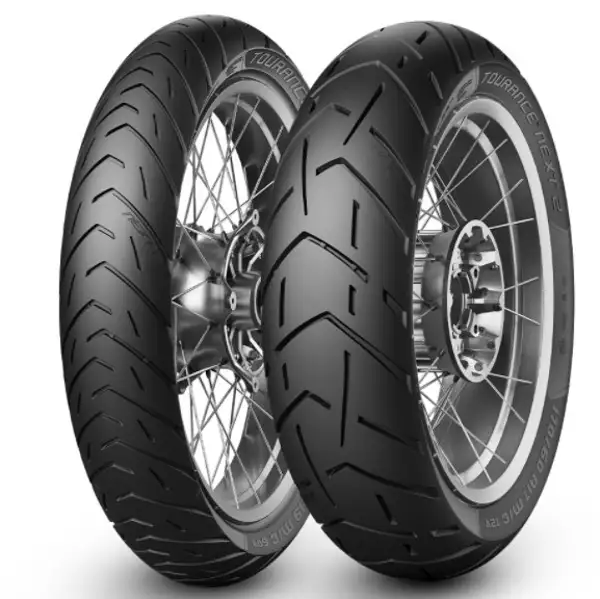
An excellent example in the 90/10 category is the Dunlop Traimax Meridian. It has excellent grip on dry and wet roads, rolls smoothly, can be driven precisely and evenly through curves. It tolerates occasional grit or dirt surprisingly well.
The Continental Trail Attack 3, Metzeler Tourance Next 2, Bridgestone A41, or the Pirelli Scorpion Trail II, which I won’t go into here, can be similarly rated.
If you want to use road tyres in ireland, I recommend to get a new set for your tour, so you have at least a little bit of thread on the tyres. Be aware tough, that you should be driving very carfully on dirt, loose chipings or gravel.
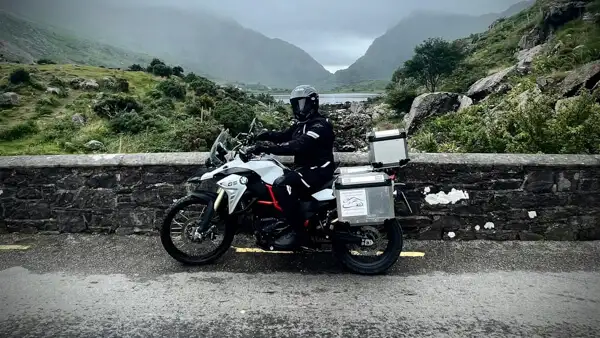
Touring endurance tyres for frequent off-road use, even in more difficult conditions
On the other side of the scale are tyres in the (50/50) or (60/40) category. These are made for travel enduro riders who also love thick gravel, some sand and mud and generally more difficult conditions. The tyres are quite chunky, but the spacing between the lug blocks is tighter than on even more specialised competition or rally tyres.
These are also suitable for off-road use, although you often have to make some concessions when riding at an angle or in wet conditions on asphalt. Due to their construction, the tyres slip or smear a little faster. Therefore, I cannot recommend these categories for pure road travel.
The great-grandfather of this category is probably the Continental TKC 80. Other examples are Michelin Anakee Wild, Metzeler Karro 3, Dunlop Trailmax Mission, Pirelli Scorpion Rally or Bridgestone Battlax AX41, which I will not go into here.
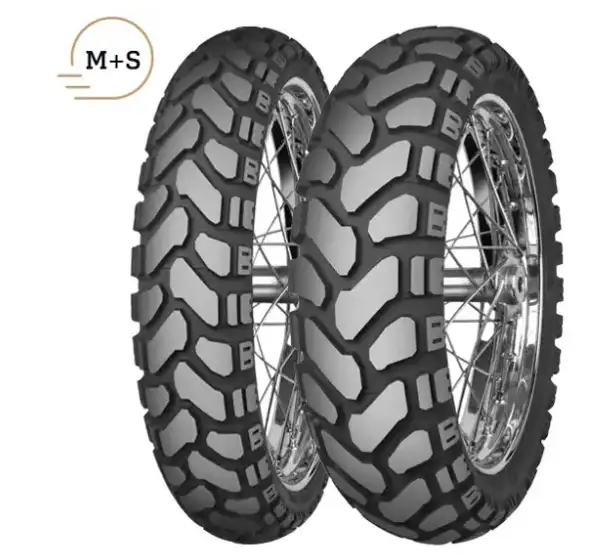
Adventure Motorbike tyres for on-road and occasional off-road use
These tyres of the (80/20) category are often fitted as original equipment on touring enduros with a 21-inch front wheel, e.g. on the Honda Africa Twin 1100. They are mainly ridden on the road, but can cope very well with short detours onto gravel roads or into light off-road terrain. They are not necessarily intended for mud or sand, the tread is still too fine for that.
The category (70/30), such as the Yamaha Tenere 700, is somewhat coarser. This means that off-road use can become more serious. Coarser gravel and some off-road wetness are no great challenge for these tyres. Wet and dry grip on asphalt are still very good, so you can also travel very well on road with these tyres.
Let’s take a closer look at a few examples of these categories:
Metzeler Karoo Street
The Karoo Street is fitted as standard, for example, on the Honda Africa Twin Adventure Sports 1100. I mainly rode it on this bike and also on our F750GS bikes. I would classify the category as (80/20), i.e. 80% road and 20% light off-road.
Visually, the tyre is by no means rough and will certainly appeal to pure road riders. In practice, the tyre convinces with its quick warm-up behaviour and excellent grip on dry roads.
Even on wet roads, the tyre feels very secure at all times and the grip remains very good. In case of light dirt or grit on the road, the Karoo Street offers noticeably more reserves than a (90/10) tyre and small detours on the (easy) gravel road are no problem either.
I find the Karoo Street to be an excellent tyre for Ireland and I like riding it myself.

Mitas E08
The E08 is less well known than its cousin, the E07/E07+, which has proven itself on many world tours. The manufacturer Mitas is also mainly known to off-road sportsmen, many road enduro riders don’t know it at all.
Quite wrongly, as I have learned! The E08 was recommended to me by an Irish professional tour guide and I rode it several thousand kilometres on both a BMW F800GS and a BMW F700GS. The tread pattern is a bit coarser and I would classify the tyre at (75/25) to (70/30), even though it is listed as (80/20) on the homapage.
With this tyre you can also ride rough gravel passages, but it is also very good on the road. Dry and wet, the grip is convincing, the rolling behaviour is pleasantly inconspicuous and the turn-in behaviour is very neutral. This tyre is very universal and very well suited for Ireland. I am very positively impressed by it and like to ride it very much.
Michelin Anakee Adventure
I got to know this tyre as original equipment on one of our BMW R1250GS. It is an (80/20) tyre and is perhaps already heading in the direction of (75/25). The tyre rides similar to the Mitas E08.
However, I have noticed that with the Anakee Adventure, the tread of the rear tyre degrades quite quickly in the centre strip, and then the rear tyre becomes a bit “squarer”. The handling is still good. The wear may be related to the weight and power of the big R1250GS, and perhaps this tyre would be a little more durable on medium and medium-heavy touring enduros.
Metzeler Tourance
I rode this tyre for about 1100km on the BMW G310GS and had a lot of fun with both, bike and tyre! I see this tyre between (80/20) and (85/15), because the tread blocks are relatively close in the middle area. The guidance in curves is very good and the grip on wet and dry roads is excellent. The small light gravel road is no problem with it. Overall, a very convincing tyre, especially for lighter or medium touring enduros.
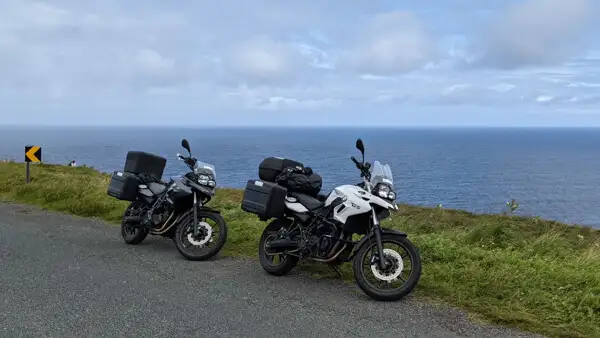
Pirelli Scorpion Rally STR
Anyone who has bought a Yamaha Tenere 700 knows this tyre, because it is fitted as original equipment. The Rally STR is in the category (70/30) and the tread looks a bit coarser.
However, you should not be deceived by this, because the Rally STR has a very good cam adhesion and also a very good wet grip on the road. The handling is pleasant and the tyre is certainly a very good choice for every tour on asphalt and also on gravel roads.
Continental TKC 70
I would classify the TKC70 at about (80/20) to (75/25). Some of the lugs are coarser, but the continuous centre rib on the rear tyre brings us back to the road. It provides a pleasant rolling behaviour and good mileage, but when it comes to wet-muddy or sandy terrain, there is a lack of cross-profiled blocks in the middle.
The tyre works very well on wet and dry roads and dry/light gravel roads are no problem. For touring in Ireland this tyre is well suited.
More tyres in these categories
Other tyres in the 80/20 category include the Dunlop Trailmax Mixtour, the Pirelli MT60, the new Bridgestone Adventure Trail AT41 or perhaps the new Michelin Anakee Street. Unfortunately, I don’t have any empirical values for these, so I can’t describe them in more detail.
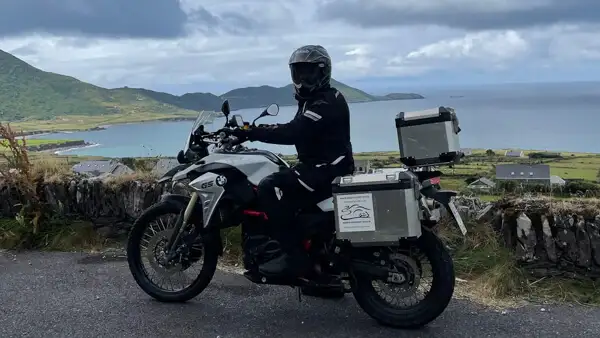
Recommendations
This overview is certainly not complete and there would be a lot more to discuss about tyres. However, I would like to emphasise three important contexts:
- in some countries one rides more often on loose or slippery surfaces than perhaps in Germany. This includes Ireland and, for example, some Mediterranean countries.
- the (90/10) tyres widely used on touring enduros work well in Ireland, provided the tread is not too worn. However, a bit of caution on rolling gravel or gravel car parks is advised.
- travel enduro tyres in the (80/20) or even (70/30) categories are much better suited in Ireland because you get more grip on bad or slippery surfaces, but have to make practically no sacrifices on the road. I can only recommend these categories!
Therefore, I would like to suggest to the pure road riders among the Adventure Motorbike riders not to automatically have the (90/10) tyre fitted the next time they change their tyres, but to have the dealer show them alternatives in the (80/20) or (70/30) categories.
Conclusion
After riding thousands of kilometres on various motorbikes in Ireland, my learning experience is that I much prefer tyres with a slightly thicker tread in the (80/20) or (70/30) category to the very road-oriented tyres (90/10).
The slightly rougher tyres offer more safety on dirty surfaces, rolling gravel or short gravel stretches, and also work very well on all road surfaces.
The selection of 80/20 tyres is very good and is currently being supplemented by new tyres. So you should be able to find good all-round tyres in all important dimensions.
My personal favourites for Ireland are currently the Metzeler Karoo Street in the (80/20) category and the Mitas E08 in the (70/30) category.
More interesting articles for you
THE BEST MOTORBIKE FOR THE IRELAND TOUR – OR OTHER TRAVELS
56 TIPS FOR PLANNING AN UNFORGETTABLE MOTORBIKE TRIP TO IRELAND!
MOTORBIKE TRIP IRELAND – WHICH REGION SHOULD I GO TO?
FROM NORTHERN IRELAND TO SCOTLAND BY MOTORBIKE – HIGHLANDS AND HIGHLIGHTS
Photo credits cover photo: Client on tour with 80/20 tyres, photo by Grahame Cahill